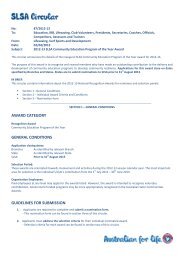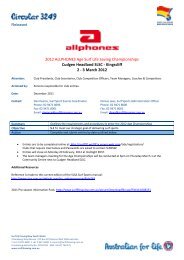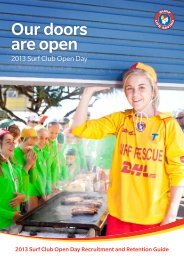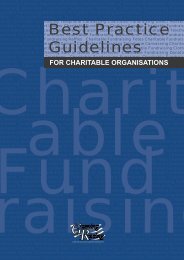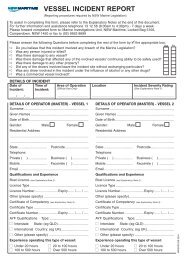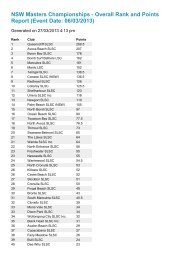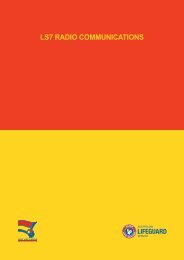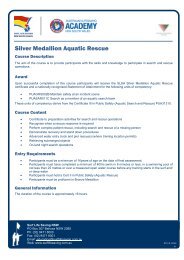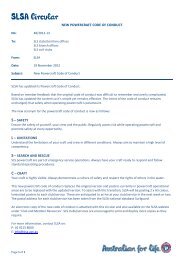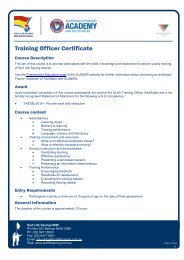LS13 LIFESAVING VESSELS AND AIRCRAFT - Surf Life Saving NSW
LS13 LIFESAVING VESSELS AND AIRCRAFT - Surf Life Saving NSW
LS13 LIFESAVING VESSELS AND AIRCRAFT - Surf Life Saving NSW
Create successful ePaper yourself
Turn your PDF publications into a flip-book with our unique Google optimized e-Paper software.
<strong>LS13</strong> <strong>LIFESAVING</strong> <strong>VESSELS</strong> <strong>AND</strong> <strong>AIRCRAFT</strong><br />
<strong>LS13</strong>. <strong>Life</strong>saving<br />
Vessels – Aircraft<br />
ST<strong>AND</strong>ARD OPERATING PROCEDURES <strong>LIFESAVING</strong> SERVICES | 257
<strong>LS13</strong>.1 RWC OPERATIONS - OVERVIEW<br />
Section: <strong>Life</strong>saving Vessels and Aircraft Page: 1 of 1<br />
Date: 22 nd September 2012<br />
<strong>LS13</strong>. <strong>Life</strong>saving<br />
Vessels – Aircraft<br />
Purpose<br />
To provide policy, procedure and best practice for the Rescue Water Craft operations.<br />
Policy<br />
<strong>Surf</strong> <strong>Life</strong> <strong>Saving</strong> <strong>NSW</strong> (SLS<strong>NSW</strong>) requires all RWC Operators to adhere to the established policies, procedures<br />
and guidelines to ensure safe and effective practices relating to RWC operations.<br />
Procedure<br />
Definitions<br />
Rescue Water Craft (RWC) Units<br />
A personal water craft commonly known as a wave runner or jet ski, operated by at least 1 qualified<br />
lifesaving personnel, that is primarily responsible for patrolling outside traditional flagged areas, with<br />
additional rescue capabilities.<br />
RWC Service<br />
A ‘zone/area’ where a RWC provides a roving and emergency response service. There may be multiple ‘RWC<br />
Services’ within a single branch.<br />
RWC Service Objective<br />
To provide operational support to existing patrols and patrolling/emergency response capacity to nonpatrolled<br />
areas/times.<br />
Scope of Operation – Patrol Season/Patrol Days/Patrol Times<br />
The minimum patrol season/hours for an RWC service shall be as agreed in the <strong>Life</strong>saving Service<br />
Agreement.<br />
A RWC service shall undertake rostered patrols on Saturdays, Sundays and Public Holidays within the patrol<br />
season.<br />
Scope of Operation – After-hours Capacity<br />
RWC services shall have the capacity to respond to after-hours/out-of-season emergencies within the scope<br />
of the Emergency Response System.<br />
<strong>Surf</strong>Coms/Callsigns<br />
RWC units shall adopt and utilise radio callsigns and communicate with a SLS<strong>NSW</strong> <strong>Surf</strong>Com as per<br />
SLS<strong>NSW</strong> SOP’s.<br />
Reference<br />
<strong>Life</strong>saving Service Agreement.<br />
SLS<strong>NSW</strong> Guide to establishing a support operation.<br />
258 | ST<strong>AND</strong>ARD OPERATING PROCEDURES <strong>LIFESAVING</strong> SERVICES
<strong>LS13</strong>.2 RWC MINIMUM EQUIPMENT<br />
Section: <strong>Life</strong>saving Vessels and Aircraft Page: 1 of 1<br />
Date: 22 nd September 2012<br />
Purpose<br />
To outline the minimum RWC equipment required for operations.<br />
Policy<br />
The following equipment shall be maintained on/in the RWC for all activities (training, patrolling,<br />
emergency response).<br />
Procedure<br />
Minimum Equipment<br />
All equipment must be SLSA approved equipment.<br />
• Rescue Sled<br />
• Rescue Tube<br />
• Spare Lanyard (Stored in the glove compartment of the RWC or on driver)<br />
• Pairing Knife<br />
• Throw rope (bag) (To be located in forward hatch)<br />
• First Aid Kit (To be located in the forward hatch. Recommended to be contained within a waterproof case)<br />
• Flares (2 smoke flares)<br />
Recommended<br />
• Waterproof Bag<br />
• Rescue Handle<br />
• Mask and Snorkel (To be stored in forward hatch)<br />
• GPS Tracking Unit<br />
• EPIRB (To be stored in forward hatch or on operator)<br />
• Bilge Pump Internal<br />
<strong>LS13</strong>. <strong>Life</strong>saving<br />
Vessels – Aircraft<br />
ST<strong>AND</strong>ARD OPERATING PROCEDURES <strong>LIFESAVING</strong> SERVICES | 259
<strong>LS13</strong>.3 RWC UNIFORM & PERSONAL<br />
PROTECTIVE EQUIPMENT (PPE)<br />
Section: <strong>Life</strong>saving Vessels and Aircraft Page: 1 of 2<br />
Date: 22 nd September 2012<br />
Purpose<br />
To outline minimum uniform and PPE requirements for a RWC Driver/Crewman.<br />
Policy<br />
Drivers and crew shall wear/have the following uniform/on their person when operating a RWC.<br />
Procedure<br />
Minimum Requirements<br />
Patrol Uniform<br />
Patrol Rash Shirt<br />
Rash Shirts to be red and yellow in colour with<br />
yellow body and red sleeves.<br />
The words SURF RESCUE must appear on the<br />
back and front of the shirt. This wording to be<br />
SLSA rash-vest (long or short arm)<br />
in red lettering, at a minimum of 60mm high x<br />
350mm wide.<br />
The SLS logo is to be shown in the centre of<br />
the shirt above the SURF RESCUE WORDS. This<br />
is to be 50mm high x 50mm wide.<br />
Rash Vest<br />
Worn over wetsuit<br />
Worn under lifejacket<br />
<strong>Life</strong>saving Equipment<br />
<strong>LS13</strong>. <strong>Life</strong>saving<br />
Vessels – Aircraft<br />
<strong>Life</strong>jacket<br />
Radio + Radio Bag<br />
Level 50 (Australian Standard)<br />
The words SURF RESCUE must appear on the<br />
wide.<br />
The SLS logo is to be shown on the front left<br />
Yellow or combination of Red/<br />
<strong>Life</strong>saving Yellow Equipment<br />
Patrol Helmet<br />
Note: <strong>Life</strong>jackets are to always<br />
Helmets are to be finished in either red or<br />
yellow, or both.<br />
be worn externally (not under a<br />
The words SURF RESCUE must appear on the<br />
back of the helmet. This to be in lettering a<br />
jacket or rash shirt)<br />
minimum of 45mm and a maximum of 55mm<br />
high.<br />
<strong>Life</strong>saving Equipment<br />
Patrol Helmet<br />
Helmets are to be finished in either red or<br />
yellow, or both.<br />
SLS<strong>NSW</strong> endorsed radio<br />
<strong>Life</strong> Vest<br />
<strong>Life</strong> vests are to be either red or yellow, or both.<br />
back of the vest in lettering 70mm high x 25mm<br />
<strong>Surf</strong> Rescue branding/SLS logo<br />
Sponsor logo<br />
breast. This is to be 50mm high x 50mm wide.<br />
<strong>Surf</strong> Rescue branding/SLS logo<br />
8<br />
26<br />
The words SURF RESCUE must appear on the<br />
back of the helmet. This to be in lettering a<br />
minimum of 45mm and a maximum of 55mm<br />
high.<br />
Helmet (Gath type)<br />
Yellow, red or chequered<br />
red/yellow<br />
Must provide coverage of entire<br />
back, top and sides of the head<br />
(including ears).<br />
Wetsuit Shorts<br />
Worn under patrol shorts or<br />
stand-alone<br />
<strong>Surf</strong> Rescue branding/SLS logo<br />
9<br />
Spare Lanyard<br />
Whistle<br />
To be stored in the glove<br />
compartment of the RWC or on<br />
driver<br />
<strong>Surf</strong> Rescue branding/SLS logo<br />
Whistle to be positioned on<br />
<strong>Life</strong>jacket<br />
9<br />
260 | ST<strong>AND</strong>ARD OPERATING PROCEDURES <strong>LIFESAVING</strong> SERVICES
<strong>LS13</strong>.3 RWC UNIFORM & PERSONAL<br />
PROTECTIVE EQUIPMENT (PPE)<br />
Section: <strong>Life</strong>saving Vessels and Aircraft Page: 2 of 2<br />
Date: 22 nd September 2012<br />
Recommended/Optional<br />
Patrol Uniform<br />
Patrol Wetsuit<br />
wetsuits are to be black, red and yellow in<br />
colour with a red trunk, yellow sleeves and<br />
black legs. Wetsuits may be of the short spring<br />
suit type or the long steamer type.<br />
The words SURF RESCUE must appear on the<br />
back and front of the suit. The lettering is to be<br />
in yellow, at a minimum of 60mm high x 330mm<br />
wide.<br />
Full suit or spring suit<br />
The SLS logo is to be shown on the left and right<br />
shoulders. The logo is to be 50mm high x 50mm<br />
wide.<br />
Wetsuit<br />
Yellow rash shirt to be worn over<br />
the top<br />
<strong>Life</strong>saving Equipment<br />
Patrol Accessories<br />
Where possible patrol accessories should be red<br />
or yellow, or both in colour.<br />
Fin Belt<br />
Worn at all times by<br />
drive/crew + fins<br />
<strong>Surf</strong> Rescue branding/SLS logo<br />
Sponsor logo<br />
Swim Fins<br />
Standard body boarding style<br />
swim fins (no dive fins)<br />
Jacket<br />
SLSA jacket<br />
Note: Windcheaters are not to be<br />
worn over the top of lifejackets<br />
7<br />
Sunglasses<br />
Booties<br />
Gloves<br />
For the provision of eye<br />
protection for UV and sea-spray<br />
For the provision of added<br />
warmth and traction<br />
For the provision of added<br />
warmth and grip-ability<br />
<strong>LS13</strong>. <strong>Life</strong>saving<br />
Vessels – Aircraft<br />
ST<strong>AND</strong>ARD OPERATING PROCEDURES <strong>LIFESAVING</strong> SERVICES | 261
<strong>LS13</strong>.4 RWC DESIGN & LAYOUT<br />
Section: <strong>Life</strong>saving Vessels and Aircraft Page: 1 of 1<br />
Date: 22 nd September 2012<br />
Purpose<br />
To outline branding and outfitting standards for RWC’s in operation in SLS<strong>NSW</strong><br />
Policy<br />
RWCs shall as a minimum be checked to the following standard.<br />
Procedure<br />
Vessel Branding<br />
Branding for all surf life saving vessels shall comply with the SLSA Equipment and Uniform Branding Policy.<br />
This policy can be obtained at www.sls.com.au.<br />
Outfitting<br />
<strong>LS13</strong>. <strong>Life</strong>saving<br />
Vessels – Aircraft<br />
Security Straps<br />
Security Bungees<br />
Seats should be equipped with<br />
straps to ensure security when in<br />
transit and when in operation.<br />
A straps shall be used for each<br />
independent seat.<br />
A strap should also be considered<br />
for the front hatch.<br />
Front hatches and glove<br />
compartments should be fitted<br />
with security bungees.<br />
Safety Padding<br />
Rear seats handles should be<br />
padded with a soft material such<br />
as pipe-lagging or soft rubber<br />
to protect personnel on the<br />
rescue sled.<br />
Wear Protection<br />
RWC’s should have the rear area<br />
of the hull, where the rescue sled<br />
meets the craft, covered with<br />
“ute liner.”<br />
This will prevent all wear and<br />
damage to the craft from the<br />
rescue sled.<br />
262 | ST<strong>AND</strong>ARD OPERATING PROCEDURES <strong>LIFESAVING</strong> SERVICES
<strong>LS13</strong>.5 RWC FIRST AID KIT<br />
Section: <strong>Life</strong>saving Vessels and Aircraft Page: 1 of 1<br />
Date: 22 nd September 2012<br />
Purpose<br />
To outline the minimum requirements for a portable RWC first aid kit.<br />
Policy<br />
All RWC’s operating within <strong>NSW</strong> shall carry a first aid kit, consisting of the following items (as a minimum):<br />
1 Waterproof case/bag 1 Conforming Bandage (10cm)<br />
1 Pocket Mask (Resus) 1 Crepe Bandage (10cm)<br />
1 Resus Face Sheild 1 Gauze Swabs (7.5cm x 7.5cm)<br />
4 Disposable Gloves (in bag) 1 Non-adherent Dressing Pad (10cm x 7.5cm)<br />
1 Medical Shears (Scissors) 1 Adhesive Dressing Tape (2.5cm x 5m)<br />
1 Emergency Blanket (Space Blanket) 1 Waterproof Notepad<br />
1 Triangular Bandage (90-100cm) 1 Pencil<br />
Procedure<br />
The nature of RWCs and their scope of operations within SLS see them tasked to support existing patrols<br />
and also respond to remote locations where no patrols exist and/or to locations not accessible via land.<br />
It is essential that the RWC is equipped (at a minimum) with a first aid kit that will enable it to deal with the<br />
life threatening types of medical incidents, being:<br />
• Resuscitation<br />
• Severe Bleeding<br />
• Hypothermia<br />
Accordingly, RWCs (which by nature are short of storage space) do not require the full inventory of first aid<br />
equipment as required by a standard patrol, rather they require specific pieces of equipment targeted at<br />
the above medical conditions.<br />
Where a non life threatening injury occurs at a patrolled location, the patrol will be equipped to deal with<br />
such. Where a non life threatening injury occurs at a remote location, the RWC will be equipped to secure<br />
the patient and prevent any life threatening condition developing while awaiting assistance.<br />
It is also essential that the case is of a type that will prevent water ingress, which will destroy the contents<br />
of the kit – a robust case is required to make the kit a feasible asset.<br />
<strong>LS13</strong>. <strong>Life</strong>saving<br />
Vessels – Aircraft<br />
ST<strong>AND</strong>ARD OPERATING PROCEDURES <strong>LIFESAVING</strong> SERVICES | 263
<strong>LS13</strong>.6 OVERVIEW OF ORB/JRB OPERATIONS<br />
Section: <strong>Life</strong>saving Vessels and Aircraft Page: 1 of 2<br />
Date: 22 nd September 2012<br />
<strong>LS13</strong>. <strong>Life</strong>saving<br />
Vessels – Aircraft<br />
Purpose<br />
To outline the requirements of Offshore Rescue Boats (ORBs), Jet Rescue Boats (JRBs) and Rigid Hull<br />
Inflatable’s (RIB’s) within <strong>Surf</strong> <strong>Life</strong> <strong>Saving</strong> <strong>NSW</strong> (SLS<strong>NSW</strong>) operations,<br />
Policy<br />
All ORB/JRB/RIB’s must maintain the following:<br />
• Hold a service/branch/state endorsed <strong>Life</strong>saving Service Agreement for each operational year.<br />
• Must maintain a 24/7 call out capability.<br />
• Must include the provision of roving patrols in regular patrol times.<br />
• Service operators/crew must be active/financial members of an affiliated SLS<strong>NSW</strong> SLSC.<br />
• Services must align and meet requirements of the relevant Branch/State constitution.<br />
• Operations shall be run in accordance with the SLS<strong>NSW</strong> SOPS and SLS<strong>NSW</strong> endorsed training manuals.<br />
• Service training must be in accordance with the SLSA awards structure.<br />
• Must maintain and meet the requirements of ‘survey’ and <strong>NSW</strong> Maritime regulations.<br />
• No service may seek or hold a State Rescue Board ‘accreditation’ without written approval from SLS<strong>NSW</strong>.<br />
• Service must align its emergency response policies and procedures with the SLS<strong>NSW</strong> Emergency<br />
Response System (no separate arrangements with emergency services or government may be entered<br />
into without SLS<strong>NSW</strong> approval).<br />
Procedure<br />
Overview<br />
ORB/JRB/RIB’s are specialist surf lifesaving marine rescue vessels. They play a vital part in surf life saving’s<br />
service delivery and emergency response system.<br />
Currently surf life saving operates 2 Jet Rescue Boats and 2 Offshore Rescue Boats Services, in <strong>NSW</strong>.<br />
New Services<br />
Any proposed new service and expansion of existing services must apply to SLS<strong>NSW</strong> for endorsement under<br />
the requirements set in the ‘SLS<strong>NSW</strong> Guide to establishing a support operation’.<br />
Jet Rescue Boats<br />
Jet Rescue Boats are craft that consist of a jet propulsion system similar to that of a RWC only larger. Jet<br />
Rescue Boats have an excellent ability to operate in surf environments, with their shallow water capability,<br />
swift turning capabilities and large surf capabilities; they are an ideal vessels for many environments.<br />
Offshore Rescue Boats<br />
Offshore Rescue Boats have derived from the greater need of vessels to rove and respond to incidents in<br />
more of an offshore capacity than that of Inflatable Rescue Boats and RWC’s. Offshore Rescue Boats are a<br />
specialised operation within surf life saving and are primarily designed to support the inshore operations of<br />
RWC’s and Inflatable Rescue Boats as well as distressed vessels and persons.<br />
Due to their larger size and capacity Offshore Rescue Boats are a response unit, first aid room, floating<br />
command post and a rescue vessel all tied into one.<br />
264 | ST<strong>AND</strong>ARD OPERATING PROCEDURES <strong>LIFESAVING</strong> SERVICES
<strong>LS13</strong>.6 OVERVIEW OF ORB/JRB OPERATIONS<br />
Section: <strong>Life</strong>saving Vessels and Aircraft Page: 2 of 2<br />
Date: 22 nd September 2012<br />
Rigid Hull Inflatable’s<br />
Rigid Hull Inflatable’s provide primarily a inshore (outside surf zone) SAR role, with greater speed and<br />
coverage capacity than an IRB.<br />
Design/Layout/Branding<br />
All newly established ORB/JRB/RIB services must have approval from <strong>Surf</strong> <strong>Life</strong> <strong>Saving</strong> <strong>NSW</strong> for the design<br />
and layout of the vessel.<br />
Branding must meet the specification of SLSA equipment branding requirements and be approved by<br />
SLS<strong>NSW</strong>.<br />
Reference<br />
SLS<strong>NSW</strong> Guide to establishing a support operation.<br />
<strong>LS13</strong>. <strong>Life</strong>saving<br />
Vessels – Aircraft<br />
ST<strong>AND</strong>ARD OPERATING PROCEDURES <strong>LIFESAVING</strong> SERVICES | 265
<strong>LS13</strong>.7 JRB/ORB EQUIPMENT<br />
Section: <strong>Life</strong>saving Vessels and Aircraft Page: 1 of 2<br />
Date: 22 nd September 2012<br />
<strong>LS13</strong>. <strong>Life</strong>saving<br />
Vessels – Aircraft<br />
Purpose<br />
To outline the minimum requirements for Jet Rescue Boats (JRB) used within <strong>Surf</strong> <strong>Life</strong> <strong>Saving</strong> <strong>NSW</strong> (SLS<strong>NSW</strong>)<br />
operations.<br />
Policy<br />
SLS<strong>NSW</strong> requires JRBs to meet the minimum standards set out by the organisation.<br />
Procedure<br />
The following details the minimum list for a Jet Rescue Boat in <strong>NSW</strong>:<br />
MEDICAL<br />
• First Aid Kit<br />
• Oxygen Resuscitation Kit<br />
• Stokes Litter<br />
• Spinal Board<br />
• Neck Braces<br />
• Blankets<br />
• Towels<br />
• Space Blankets<br />
• Body Bag<br />
SAFETY/PPE<br />
• All requirements as per ‘survey’ and <strong>NSW</strong> Maritime regulations<br />
• <strong>Life</strong>jackets<br />
• Strobe Lights<br />
• Red Parachute Flares<br />
• Red Hand Held Flares<br />
• Orange hand Held Smoke Flares<br />
• EPIRB (Emergency Position Indicating Radio Beacon)<br />
• V Sheet<br />
• Bucket with Lanyard<br />
• 2 Hand Held Search Lights<br />
• Mirror<br />
• Whistle<br />
• Signal Flags<br />
• Personal EPIRBs (recommended)<br />
LINES<br />
• Towing Lines<br />
• Towing Bridle<br />
• Diver Lines<br />
• Anchor Line<br />
266 | ST<strong>AND</strong>ARD OPERATING PROCEDURES <strong>LIFESAVING</strong> SERVICES
<strong>LS13</strong>.7 JRB/ORB EQUIPMENT<br />
Section: <strong>Life</strong>saving Vessels and Aircraft Page: 2 of 2<br />
Date: 22 nd September 2012<br />
RESCUE<br />
• 2 Rescue Tubes<br />
• Wetsuit (1 per crew)<br />
• Gath Helmets (1 per crew)<br />
• Diving Fins/Rescue Fins<br />
• Booties<br />
• Dive Masks and snorkels<br />
• Divers Knife<br />
• 2 Weight Belts<br />
• Diver Tow Bar<br />
• Diver Marker Buoys<br />
• Diver Below Flag<br />
• Dive Torch<br />
COMMUNICATIONS<br />
• SLS UHF Base-set Radio<br />
• SLS UHF hand-held radio (+bag)<br />
• 27 MHZ H.F Marine Transceiver<br />
• Cellular Telephone<br />
• AM/FM Radio Receiver<br />
• P.A System incorporating Siren/Loud Hailer<br />
NAVIGATION<br />
• Navigational Charts for <strong>NSW</strong> Coast<br />
• Dividers, Compass etc.<br />
• Boat Compass<br />
• Hand Held Compass<br />
• GPS/Depth Sounder (Global Positioning Satellite Navigation)<br />
GENERAL<br />
• 2 Fenders<br />
• Water Bottles<br />
• Chamois<br />
• Tool Kit<br />
<strong>LS13</strong>. <strong>Life</strong>saving<br />
Vessels – Aircraft<br />
ST<strong>AND</strong>ARD OPERATING PROCEDURES <strong>LIFESAVING</strong> SERVICES | 267
<strong>LS13</strong>.8 OVERVIEW OF AERIAL SERVICES<br />
(<strong>Surf</strong> <strong>Life</strong> <strong>Saving</strong>)<br />
Section: <strong>Life</strong>saving Vessels and Aircraft Page: 1 of 1<br />
Date: 22 nd September 2012<br />
<strong>LS13</strong>. <strong>Life</strong>saving<br />
Vessels – Aircraft<br />
Purpose<br />
To outline the requirements of surf life saving fixed-wing, rotary aircraft and drones conducting lifesaving<br />
operations in <strong>NSW</strong>.<br />
Policy<br />
All surf life saving aircraft must ensure/maintain the following:<br />
• Hold a service/SLS<strong>NSW</strong> endorsed <strong>Life</strong>saving Service Agreement/Contract/MOU (operational) for each<br />
operational year.<br />
• Should include the provision of roving patrols in regular patrol times (where able).<br />
• Volunteer crew shall be active/financial members of an affiliated SLS<strong>NSW</strong> SLSC.<br />
• Operations shall be run in accordance with the SLS<strong>NSW</strong> SOPS.<br />
• Service training must be in accordance with the SLSA awards structures (excluding specialist requirements).<br />
• No service may seek or hold a State Rescue Board ‘accreditation’ or be represented at any local or<br />
district rescue or emergency management committees without written approval from SLS<strong>NSW</strong>.<br />
• Service must align its emergency response policies and procedures with the SLS<strong>NSW</strong> Emergency<br />
Response System (no separate arrangements with emergency services or government may be entered<br />
into without SLS<strong>NSW</strong> approval).<br />
• Must utlise endorsed SLS<strong>NSW</strong> radio frequencies and communications channels as per SLS<strong>NSW</strong> requirements.<br />
Procedure<br />
Overview<br />
Aerial services may provide enhanced preventative patrolling and search and rescue capacity for coastal/offshore<br />
areas.<br />
New Services<br />
Any proposed new service and expansion of existing services must apply to SLS<strong>NSW</strong> for endorsement under<br />
the requirements set in the ‘SLS<strong>NSW</strong> Guide to establishing a support operation’.<br />
Non – <strong>Surf</strong> <strong>Life</strong> <strong>Saving</strong> Aerial Services<br />
No surf life saving services shall undertake joint-operating arrangements with non-SLS aerial services<br />
without the written authorisation of SLS<strong>NSW</strong>.<br />
This includes ‘private’ shark patrol companies/organisations.<br />
Design/Layout/Branding<br />
All newly aerial services must have approval from <strong>Surf</strong> <strong>Life</strong> <strong>Saving</strong> <strong>NSW</strong> for the design and layout of the aircraft.<br />
Branding must meet the specification of SLSA equipment branding requirements and be approved by SLS<strong>NSW</strong>.<br />
268 | ST<strong>AND</strong>ARD OPERATING PROCEDURES <strong>LIFESAVING</strong> SERVICES
<strong>LS13</strong>.9 HELICOPTER DEMONSTRATION REQUESTS<br />
Section: <strong>Life</strong>saving Vessels and Aircraft Page: 1 of 1<br />
Date: 22 nd September 2012<br />
Purpose<br />
To outline the procedure for lifesaving services to request helicopter demonstrations to support training and<br />
surf life saving events.<br />
Policy<br />
All lifesaving services shall adhere to the formal process for requesting helicopter demonstration support for<br />
surf life saving training/events.<br />
<strong>Life</strong>saving services shall not directly contact/request training/demonstration support from rescue helicopter<br />
services without the authorisation of SLS<strong>NSW</strong>.<br />
Procedure<br />
Support from rescue helicopters can add significant value to lifesaving service training, joint operations<br />
development and also other related surf life saving events.<br />
It is understood that rescue helicopters have priority obligations, are comparatively expensive to operate,<br />
have finite operational hours (before requiring servicing) and have CASA and other aircraft related<br />
obligations and regulations that they must meet.<br />
Where appropriate and able however support from rescue helicopters can be requested and approved.<br />
Demonstration request procedure:<br />
• Branch/club/service desiring a helicopter demonstration shall complete the ‘Helicopter Demonstration<br />
Request Form’ and submit to SLS<strong>NSW</strong> within 50 days of the event (with Branch endorsement).<br />
• If the request includes landing/rescue demonstration written approval from the land manager (i.e<br />
council) must be provided with the form.<br />
• SLS<strong>NSW</strong> shall consider the request and liaise with the request helicopter service accordingly.<br />
• Should the request be approved and the rescue helicopter service available, a more detailed operations<br />
brief may be required and local contacts/contingencies put in place.<br />
• Rescue helicopter services shall retain the right to cancel/postpone any planned attendance (without<br />
prior notice) should a priority tasking, weather issue or any other issue arise.<br />
Reference<br />
Helicopter Demonstration Request Form.<br />
<strong>LS13</strong>. <strong>Life</strong>saving<br />
Vessels – Aircraft<br />
ST<strong>AND</strong>ARD OPERATING PROCEDURES <strong>LIFESAVING</strong> SERVICES | 269
270 | ST<strong>AND</strong>ARD OPERATING PROCEDURES <strong>LIFESAVING</strong> SERVICES





